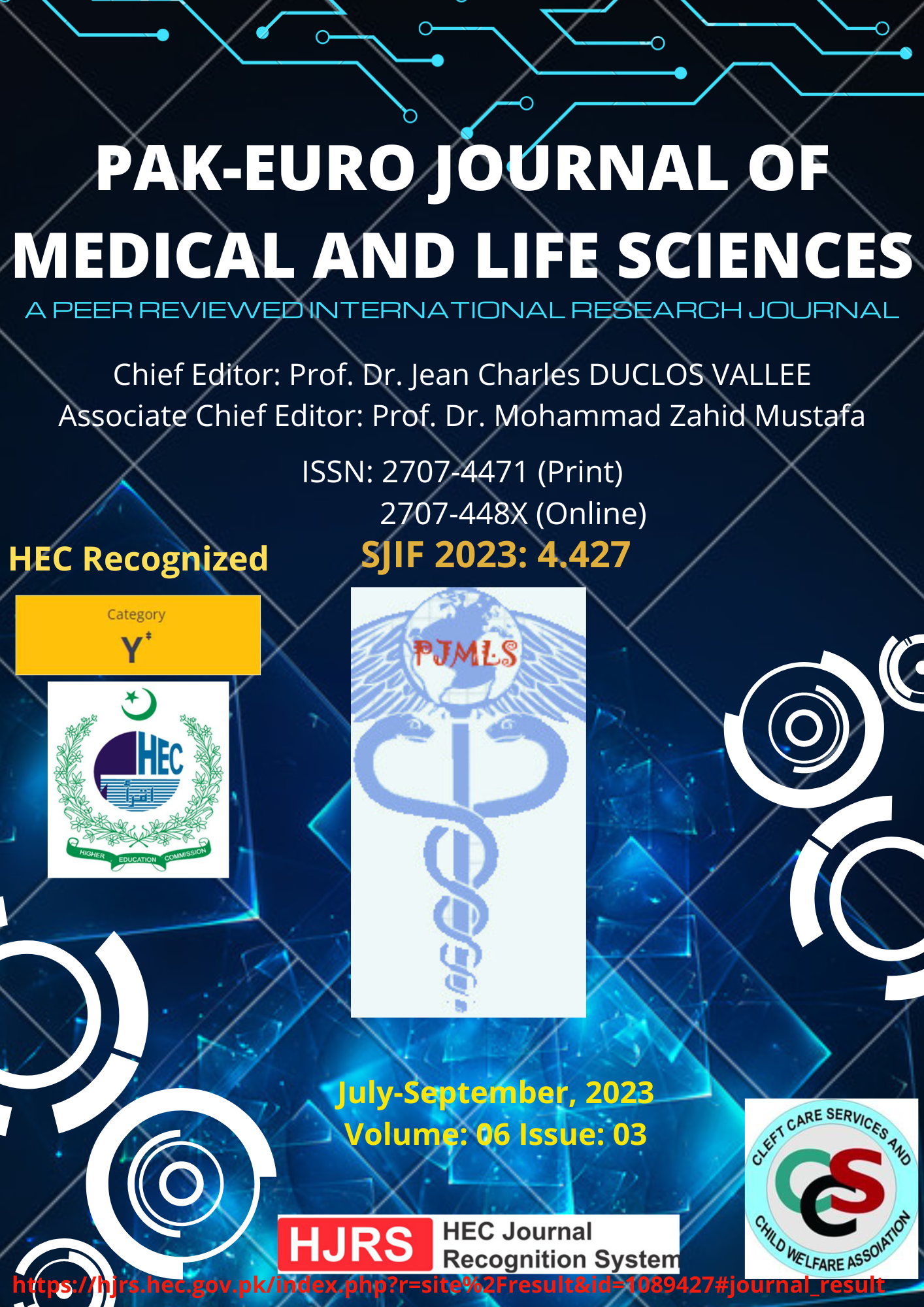Guardians of Quetta's Skies: Aeshnidae Dragonflies Explored
DOI:
https://doi.org/10.31580/ztas6j41Keywords:
Anax immaculifrons, Anax parthenope, Aeshnidae, Dragonfly, Quetta, BlochistanAbstract
Objective: With an emphasis on exploring the species richness of dragonflies (family Aeshnidae) throughout the city, this study aimed to improve knowledge of Odonate biodiversity in Quetta. The study's objective was to provide insightful information about Quetta’s dragonfly (Aeshinidae) population, highlighting a comparatively neglected feature of the area’s biodiversity.
Methodology: The surveys were conducted throughout the summer seasons spanning from 2022 to 2023. A total of 212 specimens of dragonflies were captured with the help of sweep nets. Identified specimens up to species level and then preserved.
Results: The results showed that the Anax partheope 55% and Anax immaculifrons 45% were identified from the family Aeshinidae of the genus Anax. Comprehensive information is available for each species, including their valid scientific names, habitat descriptions, ecological observations, and distributional ranges. Conclusion: Anax immaculifron is reported for the first time from Quetta Balochistan.
Conclusion: A notable contribution to the biodiversity of Odonates in Balochistan has been made with the identification and recording of Anax immaculifron in Quetta. The recognition of Anax immaculifron for the first time in Quetta highlights the necessity of extending the study, conservation efforts, expansion in range,potential for further research and to conduct out more observations and studies to fully understand the behaviour, distribution patterns, and ecological preferences of Anax immaculifron in Quetta.
References
Mongabay -environmental science and conservation news. 2016.
Burki SJ. Karachi: Climate Data Processing Centre (CDPC), Pakistan Meteorological Department. 1961.
Bybee SM, Kalkman VJ, Erickson RJ, Frandsen PB, Breinholt JW, Suvorov A. Phylogeny and classification of Odonata using targeted genomics. Mol Phylogenet Evol. 2021;160(107115):107115.
Neog N, Rajkhowa S. Dragonfly diversity in two different ecosystems in and around Assam University, Silchar (Ecoforest and Irongmara). Journal of entomology and zoology studies. 2016;4(4):184–90.
Ameilia ZS, Salmah C, Abu MR. Diversity and distribution of dragonfly (Odonata: Insecta) in the Kerian River Basin. Kedah- Perak, Malaysia. University of Sains Malaysia; 2006.
Tiple AD, Khurad AM, Andrew RJ. Species Diversity of Odonata in and around Nagpur City, Central India. Central India Fraseria (Proceeding of the 18th International Symposium of Odonatology). 2008;7:41–5.
Kalkman VJ, Clausnitzer V, Dijkstra K-DB, Orr AG, Paulson DR, van Tol J. Global diversity of dragonflies (Odonata) in freshwater. Hydrobiologia. 2008;595(1):351–63.
Futahashi R. Color vision and color formation in dragonflies. Curr Opin Insect Sci [Internet]. 2016;17:32–9.
Subramanian KA. Dragonflies and damselflies of Peninsular India-A field guide. E-Book of Project Lifescape. Vol. 118. Bangalore, India; 2008.
EncyclopediaBritannica.2013.
Suhonen J, Hilli-Lukkarinen M, Korkeamaki E, Kuitunen M, Kullas J, Pettinen J, Salmela J. Local Extinction of Dragonfly and Damselfly Populations in Low- and High-Quality Habitat Patches.Conservation Biology.2002;24(4), 1148-53.
Sheldon F, Walker KF. Spatial distribution of littoral invertebrates in the lower Murray - Darling River system, Australia. Mar Freshw Res [Internet]. 1998;49(2):171.
Catling PM. A potential for the use of dragonfly (Odonata) diversity as a bioindicator of the efficiency of sewage lagoons. The Can Field. 2005;119:233–6.
Acquah D, Kyerematen R, Owusu EO. Using odonates as markers of the environmental health of water and its land related ecotone. International Journal of Biodiversity and Conservation [Internet]. 2013;5(11):761–9.
Catling PM. A potential for the use of dragonfly (Odonata) diversity as a bioindicator of the efficiency of sewage lagoons. The Can Field. 2005;119:233–6.
Berquier C,Orsini A,and Andrei-Ruiz M.Odonata Community Index-Corsica (OCIC):a new biological index based on adult odonata population for assessment of the ecological status of watercourses in Corsica.journal ecological indicator .2016;66:163-172.
Akber A, Mehmood SA, Panhwar WA, Ahmed S, Tabassum S, Rajput A. collection and identification of Genus Anax(Odonata,Aeshinidae) from district Swat. Journal of Entomology and Zoology studies. 2017;5(2):1440–2.
Zia A, Naeem M, Rafi MA, Naz F, Afsheen S, Ilyas M. Damselflies (Zygoptera: Odonata) of Pakistan: Part 1. Journal of Insect Science. 2011;11(1).
Fraser FC. The Fauna of British India Including Ceylon and Burma.1936. In: 1_ 3)Today and Tomorrow’s Printers & Publishers New Dehli-5. 1936.
Khaliq A, Maula F. Records of dragonflies from Swat valley, Pakistan. Pakistan” Fraseria. 1999;6(1 & 2):1–2.
Chaudhary MT, Mohsin A, Shaheen FA, Arshad M, Zia A. Dragonflies (Odonata: Anisoptera) of Pakistan. Pakistan Journal of Zoology. 2016;(6):1957–62.
Yousuf M. Ph.D. Thesis, Dept. Entomol., W.P. A. U. Lyallpur, Pakistan;1972
Linnaeus C. Systema Naturae. Systema naturae per regna tria naturae :secundum classes, ordines, genera, species, cum characteribus, differentiis, synonymis, locis (in Latin) (10th ed.). Stockholm: Laurentius Salvius. 1758;(10)1:1-1384.
Selys-Longchamps M. E de. Vide. Fauna of British India, odonata. Taylor and Francis. 1831-1902. Vol.1, Ltd., Lond.
Martin K J. Odonata collected by Lt. Col. Nurse chiefly in N.W. India. Trans. Entomol. Soc. Lond. 1907;(2): 303-308.
Rambur M P.Histoire naturelle des Insects. Nevropteres. Paris. 1842;17(1):291- 8.
Chaudhry MT. Biosystematics of dragonflies (Anisoptera: Odonata) of Pakistan. Rawalpindi, Pakistan; 2010.
Chaudhry MT, Aslam M. Anax indicus Lieftinck 1942 (Odonata: Anisoptera: Aeshnidae) an addition in the fauna of Pakistan. Pak J Zool. 2010;42(1):99–101.
Chaudhry MT,Aslam M and Naeem M . “New record of genus GynacanthaeshnaFraser, 1922 (Odonata: Anisoptera: Aeshnidae) from Pakistan.” Pak. J. Zool. 2010;42(4):501-503.
Jehangir. Z. M.Sc. Thesis. Department of Agriculture Entomology University Agriculture Faisalabad, Pakistan;1997.
Ahmad A. M. Sc. Thesis. Department of Agriculture Entomology University Agriculture Faisalabad, Pakistan;1994.
Mehmood SA, Ahmed MS, Ahmed ZA, Shah S, Khan M. Molecular and Phylogenetic Analysis of Family Aeshnidae of Hazara Region Pakistan. International Journal Of Agriculture & Biology. 2021:109–16
Downloads
Published
Issue
Section
License
Copyright (c) 2023 Pak-Euro Journal of Medical and Life Sciences

This work is licensed under a Creative Commons Attribution 4.0 International License.






